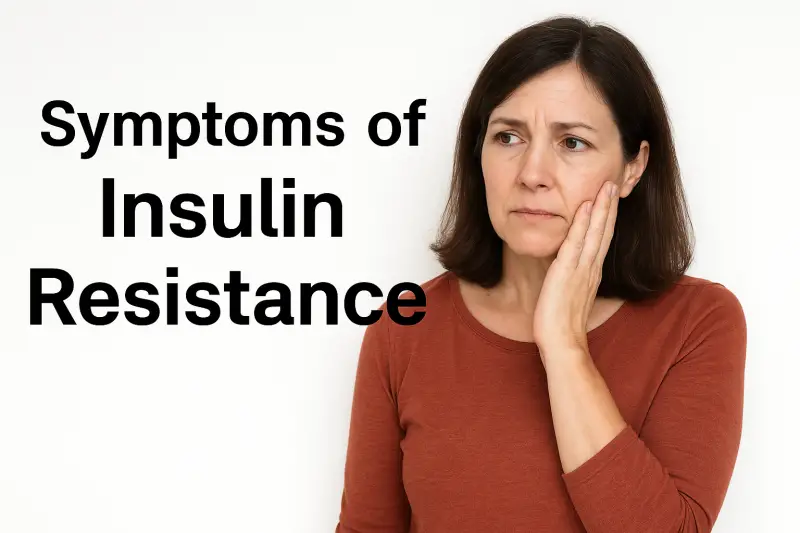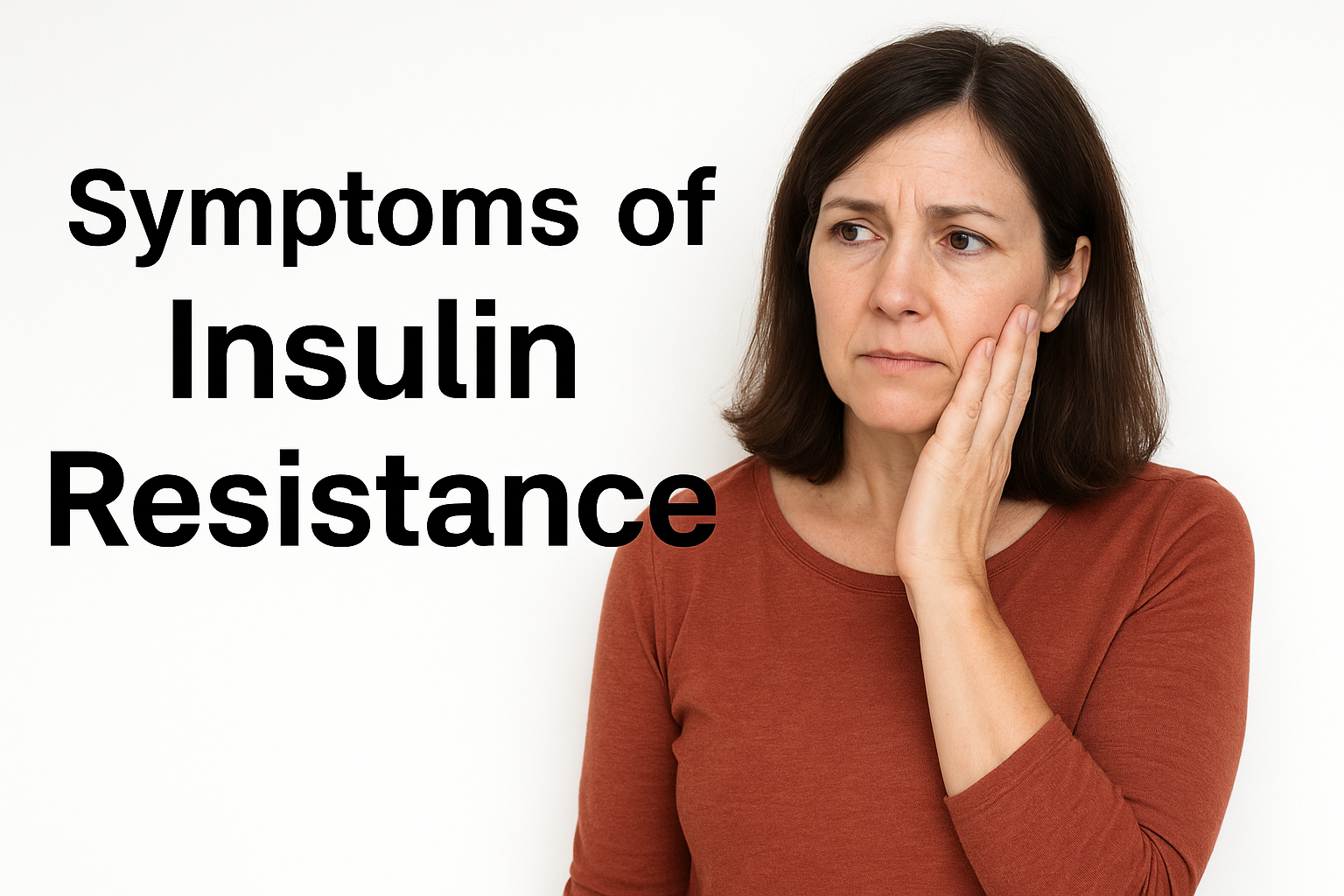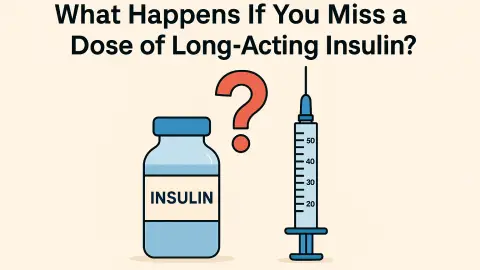Insulin resistance develops slowly and silently, often long before most people notice anything is wrong. Because early symptoms appear mild and scattered, they are easy to dismiss as normal tiredness, aging, or stress. However, insulin resistance is a metabolic warning sign that your cells are struggling to respond to insulin, forcing your pancreas to produce more of it. Over time, this hormonal imbalance triggers noticeable physical and behavioral symptoms that should never be underestimated.
Recognizing these signals early is crucial because insulin resistance is reversible in its early stages. When ignored, it progresses toward prediabetes, type 2 diabetes, fatty liver disease, obesity, PCOS, and cardiovascular issues. Below are the 10 symptoms of insulin resistance, explained in detail and arranged in a clear numerical structure so you can easily identify each one.
1. Persistent Fatigue and Low Energy Levels

Why This Symptom Appears
Persistent fatigue is one of the earliest signs of insulin resistance. Your cells struggle to absorb glucose even when insulin is present, leaving them unable to produce enough energy. Despite eating regularly, you may still feel exhausted because your cells aren’t getting the fuel they need.
How It Feels in Daily Life
You might experience morning tiredness even after a full night’s sleep, or feel drained shortly after meals. Afternoon energy crashes become more common, and you may rely heavily on caffeine to stay alert.
Why You Should Not Ignore It
Fatigue is a foundational sign that your metabolism is no longer functioning efficiently. Ignoring it allows insulin resistance to worsen without detection.
2. Unexplained Weight Gain, Especially Around the Belly
Why This Symptom Appears
Insulin is a storage hormone, and when it stays elevated for long periods, your body tends to store fat more easily—particularly visceral fat around the midsection. Insulin resistance makes burning fat extremely difficult even if you exercise.
How It Affects Your Body
People often notice a soft, stubborn layer of fat forming around their abdomen. This belly fat does not respond well to dieting or exercise because high insulin levels override fat-burning signals.
Why You Should Not Ignore It
Abdominal fat is strongly linked to inflammation, fatty liver disease, and long-term metabolic issues. It is one of the clearest external markers of insulin imbalance.
3. Constant Hunger and Sugar Cravings
Why This Symptom Appears
Insulin resistance disrupts hunger-regulating hormones such as leptin and ghrelin. When cells can’t absorb glucose properly, your body believes it’s low on energy and sends stronger hunger signals—even if you’ve just eaten.
How It Shows Up
You may crave sweets after meals or feel an intense need to snack between meals. Hunger appears frequently and suddenly, especially after consuming carbohydrates.
Why You Should Not Ignore It
If left unchecked, chronic overeating and sugar cravings accelerate blood sugar spikes and deepen insulin resistance.
4. Dark, Velvety Skin Patches (Acanthosis Nigricans)
Why This Symptom Appears
High insulin levels overstimulate skin cells, causing them to multiply and darken. This leads to thick, velvety patches of skin called acanthosis nigricans.
Where It Usually Appears
These areas most commonly appear on the back of the neck, under the arms, around the groin, and occasionally near the elbows or knuckles.
Why You Should Not Ignore It
This is one of the most visible and reliable signs of chronically elevated insulin and should be taken seriously.
5. Signs of Prediabetes or Rising Blood Sugar Levels
Why This Symptom Appears
When the pancreas can no longer keep up with excess insulin production, blood sugar begins to rise. This is when prediabetes starts to appear.
How It Feels Physically
You might notice increased thirst, more frequent bathroom trips, or occasional blurry vision after consuming sugar. Blood tests may show elevated fasting glucose or HbA1c levels.
Why You Should Not Ignore It
Prediabetes is reversible, but only if addressed early. Ignoring these early markers increases the risk of diabetes.
6. Difficulty Losing Weight Even with Diet and Exercise
Why This Symptom Appears
High insulin levels block fat-burning. Even if you reduce calories or exercise consistently, your body remains in “fat storage mode.”
Daily Impacts
Your weight may plateau despite your efforts. You may feel discouraged when your diet and exercise routine fail to produce noticeable changes in fat loss.
Why You Should Not Ignore It
When weight loss becomes unusually difficult, it often means a deeper metabolic issue is at play.
7. Post-Meal Fatigue and Afternoon Energy Crashes
Why This Symptom Appears
Insulin-resistant bodies release large amounts of insulin after meals, especially meals rich in carbohydrates. This creates rapid swings in energy levels, causing you to feel sleepy shortly afterward.
How It Affects Daily Life
You may feel mentally foggy or physically heavy after eating. Productivity and focus decline during the afternoon, especially after lunch.
Why You Should Not Ignore It
Post-meal fatigue is a direct reflection of how poorly your cells are processing glucose.
8. Frequent Urination and Increased Thirst
Why This Symptom Appears
When blood sugar begins to rise due to insulin resistance, the kidneys work overtime to remove the excess glucose. This leads to more frequent urination and dehydration, which triggers intense thirst.
Daily Challenges
You may wake up at night to urinate or feel the need to drink constantly. Dry mouth and dehydration become bothersome.
Why You Should Not Ignore It
These symptoms often mean blood sugar regulation has already begun to fail and should not be taken lightly.
9. Elevated Blood Pressure or Abnormal Cholesterol Levels
Why This Symptom Appears
Insulin resistance disrupts vascular function, causing arteries to stiffen and increasing sodium retention. It also negatively impacts cholesterol—triglycerides rise while HDL (“good” cholesterol) drops.
How It Shows Up in Tests
Your doctor may find consistently elevated blood pressure or abnormalities in cholesterol and triglyceride levels even if you maintain a relatively healthy lifestyle.
Why You Should Not Ignore It
These are early warning signs of metabolic syndrome and significantly increase the risk of cardiovascular disease.
10. Brain Fog, Poor Focus, and Slower Thinking
Why This Symptom Appears
Insulin plays a major role in brain energy metabolism. When brain cells cannot use glucose effectively, cognitive performance declines. High insulin also contributes to inflammation, which worsens brain fog.
How It Impacts Your Mind
You may feel mentally slow, forgetful, or easily distracted. Tasks requiring focus may become harder, especially after meals.
Why You Should Not Ignore It
Brain fog reflects deeper metabolic dysfunction and should never be dismissed as simple tiredness.
Additional Signs That May Accompany Insulin Resistance
Although the ten symptoms above are the most common, other signs sometimes appear alongside them. Some individuals develop skin tags, experience mood swings, face hormonal imbalances, or struggle with irregular sleep patterns. Women may experience symptoms of PCOS, and men may notice reduced testosterone levels. These signals add depth to the metabolic picture and further indicate the presence of insulin resistance.
Who Is Most Likely to Develop Insulin Resistance?
Insulin resistance is more likely to develop in individuals with sedentary lifestyles, poor dietary habits, chronic stress, or inadequate sleep. Genetic factors also increase the risk, particularly if you have close relatives with type 2 diabetes. Excess belly fat, hormonal disorders, and diets high in processed foods make insulin resistance even more likely. Recognizing these risk factors helps you understand your own vulnerability and respond early.
How to Reverse Insulin Resistance Naturally
Reversing insulin resistance requires supporting your body with healthy habits that improve insulin sensitivity. Prioritizing whole foods, balancing carbohydrates with protein and healthy fats, and reducing intake of sugary and processed foods help stabilize blood sugar. Regular physical activity—especially strength training and cardio—improves how your muscles absorb glucose.
Sleep is just as important. Poor sleep increases cortisol and hunger hormones, making insulin resistance worse. Stress management techniques such as meditation, deep breathing, yoga, or even daily walking help lower inflammation and support metabolic recovery. Regular blood tests provide insight into your progress and ensure your metabolic health stays on the right track.
When You Should See a Doctor
If you recognize several symptoms from the numbered list above, or if you have a family history of diabetes, medical evaluation is strongly recommended. Persistent fatigue, abdominal weight gain, intense cravings, or signs of prediabetes should never be ignored. Early diagnosis improves your chances of reversing insulin resistance before complications arise.
Final Thoughts
Insulin resistance develops quietly, but the body sends clear warning signs. Each of the ten symptoms above provides valuable insight into your metabolic health. By paying attention to these early signals and taking action early—through nutrition, movement, sleep, and stress management—you can stop insulin resistance from progressing into more serious conditions. Understanding these symptoms empowers you to make informed choices and protect your long-term health.
FAQs about Symptoms of Insulin Resistance
1. What is the earliest symptom of insulin resistance?
The earliest symptom is usually persistent fatigue, especially after meals. This happens because your cells struggle to absorb glucose, leaving you low on energy.
2. Can you have insulin resistance without being overweight?
Yes. Although weight gain is common, many people with normal weight still develop insulin resistance due to genetics, stress, poor sleep, or inactivity.
3. How do sugar cravings relate to insulin resistance?
Insulin resistance prevents glucose from entering cells effectively, causing the body to crave fast sources of energy such as sugary or carb-heavy foods.
4. Are dark neck patches always a sign of insulin resistance?
Dark, velvety patches—acanthosis nigricans—are strongly associated with high insulin levels but can rarely appear due to other hormonal issues.
5. Can insulin resistance cause bloating or belly fat?
Yes. Elevated insulin promotes fat storage around the abdomen and can slow digestion, contributing to bloating and increased waist size.
6. Does insulin resistance affect mental clarity?
Absolutely. Many people experience brain fog because brain cells also depend on insulin to use glucose efficiently.
7. How long does it take to reverse insulin resistance?
Reversal time varies, but many people see improvement within weeks to months through consistent lifestyle changes like diet, exercise, and better sleep.
8. What foods are best to reduce insulin resistance?
Foods rich in fiber, lean proteins, healthy fats, and low-glycemic carbohydrates help stabilize blood sugar and improve insulin sensitivity.
9. Can exercise alone fix insulin resistance?
Exercise helps significantly, especially strength training, but combining it with diet changes, stress reduction, and sleep improvement is far more effective.
10. When should I see a doctor about insulin resistance symptoms?
If you experience multiple symptoms—such as fatigue, belly fat, cravings, or dark skin patches—you should consult a healthcare professional for testing.
Disclaimer: This article is for informational and educational purposes only and is not intended as medical advice. Always consult a qualified healthcare professional regarding any symptoms, health concerns, or treatment decisions related to insulin resistance or other medical conditions.



